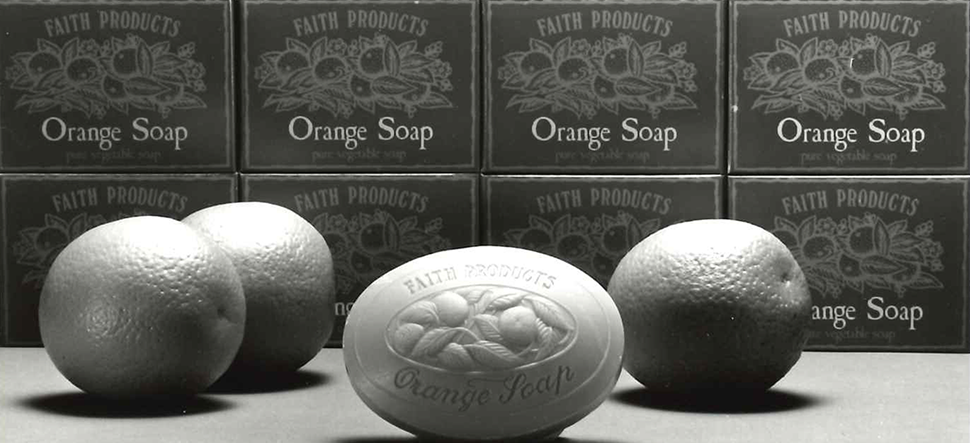
1, September 2023
The History of Soap
We’ve been making soap since 1974, but it’s been around a lot longer than that. How long, exactly? Settle in for a swift(ish) history of the sudsy stuff.
When Was Soap Invented?
The very first soap might well have been discovered by accident. It was made of tallow (animal fat) and wood ash – and it’s easy to imagine how the two substances could have come into contact when food was cooked over open fires.
The earliest evidence of soap comes from ancient Babylon: clay cylinders inscribed with instructions on how to make soap, probably dating back to around 2800 BC. But it’s unlikely that the Babylonians were bathing with it; historians think this early incarnation of soap was used to wash textiles and laundry.
Skip forward a thousand years or so and the ancient Egyptians were also producing soap; papyrus from around 1500 BC shows that it was made from a combination of fats and alkaline salts. It is thought, however, that this soap was used for medicinal purposes, such as treating wounds, rather than everyday bathing.
Did the Ancient Romans Use Soap?
If the ancient Babylonians and the ancient Egyptians weren’t bathing with soap, surely the Ancient Greeks and Ancient Romans were? Those people loved fancy baths, after all. It’s thought that soap, or a variation of it, was made in ancient Greece and Rome, but again, it was used for washing clothes (or colouring hair!). Bath-time in these ancient civilisations usually involved slathering on oil, then scraping it away with a reed or metal implement called a strigil.
Did People in the Middle Ages Use Soap?
The Middles Ages have something of a grubby reputation, but it was during this time that soap became a must-have among the European privileged. It’s believed that crusaders returned from their trips bringing Aleppo soap, an olive and laurel oil-based product from Syria. Throughout the Islamic Golden Age, Middle Eastern soap-makers experimented with vegetable fats, especially olive oil, to make a more solid formula that might have been the first vegan soap bar. Imported soap became fashionable amongst the upper middle classes, but it’s thought that less wealthy people made their own, functional and gloopy version of soap at home.
Vegan Soap Takes Off in Europe
Before long, Europeans began to create their own versions of this soap from afar. Soap-makers in the Mediterranean region couldn’t source laurel oil as easily as those in the Middle East, so they left it out of the recipe and worked with olive oil alone. The result was a solid white product called Castile soap, named after the Crown of Castile. Although this variety of soap was made all over Spain, the Castile region was the main and most esteemed producer. Queen Elizabeth I was said to love Castile soap, and it still has the same name today.
Later in the 1600s, bathing became unfashionable because it was considered to be unhygienic. King Louis XIV famously rarely bathed, but considered keeping his clothes crisp and clean essential. Around this time, people might not have been using soap to wash their bodies, but they did use it to launder their garments.
A Tax On Soap
In 1712, England imposed a tax on soap, making it a luxury item. The price of even the most basic soap tripled, meaning it was no longer accessible to most people. And the soap-making industry was heavily regulated: manufacturing equipment had to be locked away when not in use, and those boiling soap had to produce a minimum of one imperial ton every time they boiled.
Many soap-makers were forced to move overseas to places like Ireland, where soap tax didn’t exist. The tax lasted a shocking 141 years, during which time soap smuggling became commonplace as people sought to avoid the tax. It was only repealed in 1853.
Soap Goes Big
Around the time that the soap tax was lifted, the Industrial Revolution was well underway. Machinery took over from artisans and soap began to be produced on a much larger scale. Soap-making became one of the fastest-growing industries in the United States, and demand was further increased by the growth in popularity of advertising campaigns.
Soap Brings Hope
During the Crimean War, nurses Mary Seacole and Florence Nightingale pioneered their approaches to nursing. At the heart of their healthcare was one golden rule: washing hands. It might seem obvious to us now, but back then, it was news.
“Every nurse ought to be careful to wash her hands very frequently during the day,” wrote Nightingale in her 1860 book Notes on Nursing.
Soap became known as a crucial weapon in the battle against fatal diseases such as cholera. When civil war broke out in America just five years after the end of the Crimean War, army hospitals were armed with soap. Hand-washing with soap reduced fatalities in the battlefield.
A company called Procter and Gamble supplied soap to soldiers, who then took it home and recommended it to friends and family. Before long, it became a household name.
Bathrooms Move Inside
Around a hundred years ago, most people in the UK only had access to an outdoor toilet at home. It was only after the World War 2 that indoor bathrooms became the norm. Even in the mid-sixties, only 25% of homes in the UK had indoor plumbing. In the seventies, more homes began to have bathrooms installed and soap became a must-have.
Rivka Makes Her First Soap
Suddenly, everybody wanted soap, and there were lots of varieties on offer. There was soap on a rope, deodorant soap – in America you could even buy a teddy bear-shaped soap that ‘grew fur’.
In the early seventies, our founder, Rivka Rose, had New York to Scotland, having trained in herbalism in the US. She couldn’t find the natural, vegan, kind-to-skin products she wanted to use herself, so she began to make her own. In 1974, she pawned her jewellery to buy ingredients and Faith In Nature was born. One of the first products Rivka made was her Orange Vegetable Soap. Almost 50 years on, our handmade Orange Soap is still much-loved.
Liquid Soap goes En Vogue
In the 1980s, liquid soap and shower gel burst on to the soap scene and became an instant hit. Although these were chemically more likely to be detergents than soap, people loved them and their aesthetically-pleasing bottles. Another big boost for these products was the idea that bar soap was unhygienic, with many believing it harboured bacteria between washes. Marketing campaigns capitalised on this belief; one 1980s advertisement for liquid soap described bars as ‘dirty’ and ‘mushy’.
A 1988 scientific study found that washing with bar soap was unlikely to spread bacteria, but by this time, the popularity of bottled products was gaining momentum. Throughout the 80s and 90s, bar soap was widely considered old-fashioned, and many consumers opted for bottled products instead.
Bar Soap’s Big Comeback
What goes around comes around, and it seems that collectively, we’re falling back in love with bars of soap. Yay! In 2019, analysis found that people in the UK were buying 4% more soap than the year before.
One of the main drivers of soap’s comeback is thought to be its eco credentials. As more of us care about our plastic consumption and the effect it has on the planet, soap offers a convenient way to wash without the waste.
There’s something very special about soap: it’s been around for thousands of years, offers effective cleaning, is reliable, convenient and versatile. A fresh bar of soap is a thing of beauty; just unwrapping it from its box and inhaling the scent is a treat. Soap has certainly earned its big return – you can read more about why we love it so much in our ‘Benefits of a Natural Soap Bar’ blog.
Not fallen back in love with soap yet? Give it a try and remind yourself why it’s been going for approximately 5000 years.




